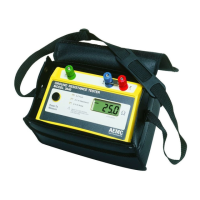34
Digital Ground Resistance Tester Model 3640 and 4610
4.10 Soil Resistivity Measurement Procedure (4-Point)
Assumingthattheobjectiveislowresistivity,preferenceshouldbegiven
toanareacontainingmoistloamasopposedtoadrysandyarea.Consid-
erationmustalsobegiventothedepthatwhichresistivityisrequired.
• DisconnecttheshortingstripfromtheXandXvterminals.
• Arrangetheelectrodesinastraightline.Besurethatdistancesbetween
electrodesareidentical:e.g. 3 metersbetween eachelectrode (See
Figure20).
• Thedistancebetweenpolesisproportionaltotheaveragedepthofthe
soilsampleyouwishtomake.
• Theelectrodesshouldbeplacedatadepthofapproximately6inches
(0.15meters),sothatthedepthisapproximately1/20thofthedistance
betweenelectrodes.
• UseleadstoconnecttheX,Xv,Y,andZelectrodestotherespective
terminalsontheDigitalGroundResistanceTester.
• Pressthe“Measure”button.
• Readtheresistancelevel(R)indicatedonthedisplay.
• In the event of difculties in performing measurements, consult the
previousinstructionsconcerninggroundresistancemeasurements.
• Applythefollowingformulainordertodetermineresistivity(ρ):
ρ
= 2πxRxA
A=distancebetweenelectrodesinmeters
ρ
= resistivity in Ω meters
R=ohmsreadingobtainedonModel4610
Example 1: For measurement performed in soil with a high limestone content, the
reading is R = 225Ω, with A = 3 meters.
ρ
= 2πx225Ωx3m
ρ
= 4239Ωm
Example 2: After inspection, the area to be investigated has been narrowed down
to a plot of ground approximately 75 square feet (22.5m
2
). Assume that you need to
determine the resistivity at a depth of 15 feet (457cm). The distance “A” between
the electrodes must then be equivalent to the depth at which average resistivity is
to be determined (15 ft, or 450cm). Using the more simplified Wenner formula (
ρ
= 2πAR), the electrode depth must then be 1/20th of the electrode spacing or 8⅞"
(22.5cm). If the electrode depth is greater than 1/20th of the electrode spacing, the
following formula must be used:

